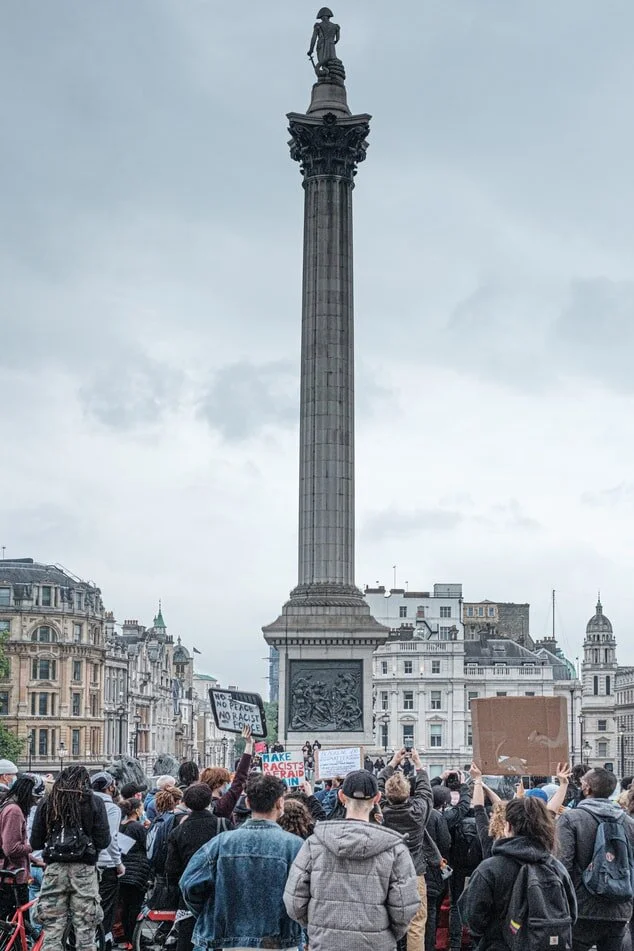Contested Histories In Public Spaces
Though the world has spent a year restricted from gathering in public places, an opportunity is among us to rethink the spaces in which we congregate, relearn what they mean to us, and rewrite the stories that they tell.
Black Lives Matter Peaceful Protest in Trafalgar Square, London, 2020. Image by Ehimetalor Akhere Unuabona, via Unsplash.
Urban landscapes are easily conceived as the settings of stories, but we often forget that they also narrate them. Public spaces tell tales old and new, truths and adaptations, to the locals and visitors who move through them. As we gather in and pass by cobwebs of streets, town squares, parks, monuments and building facades bearing the names, faces, stories and symbols of the past, we absorb and comply with their underlying historical narratives. Young minds, ears that have heard the tales a hundred times, foreign eyes and local hearts are all equally impressionable to the memories that the spaces and structures around us continually reinforce.
As it documents controversial historical narratives in public spaces across the globe, the Institute for Historical Justice and Reconciliation’s Contested Histories in Public Spaces project pivots around the core concept that the versions of history which we are continually retelling can be slanted, painful, and engaged in heated social debate. The fundamental notion that physical spaces and tangible objects can communicate memories of past – and at times misrepresent it or glorify disquieting truths – stretches far beyond the urban contexts which IHJR research investigates. Since histories are so deeply woven into the urban fabric of towns and cities all over the world, contesting them is more a matter of archaeology than it is of activism; it requires digging up the tangible and intangible landscapes of the urban environment on both small and large scales.
Outcries for truthful representation of the past and restitution for injustices, both historical and ongoing, were amongst the most characteristic global events of 2020. While daily lives became increasingly sedentary and virtual, awareness to socio-political issues peaked, and activism was arguably more active than we have seen in a long while. A significant proportion of these pleas for justice and reconciliation had to do with, or rather were embodied by, the overturning of public spaces to the public – every single human soul within the multicultural, ethnically and socioeconomically diverse public. Statues and monuments that normally remained in the fuzzy peripheral view of passer-bys became focal points, in the interest of addressing the uncomfortable but honest histories behind them which made public settings inherently biased, prejudiced spaces. Protestors on the waterside in Bristol took matters into their own hands, while others echoed their demands for the removal of monuments honouring figures guilty of human trafficking, slavery and murder, or at least for the totality of their wrongdoings to be commemorated plainly.
Rhodes Must Fall Statue Removal, Cape Town, 2015. Image via Desmond Bowles (CC BY SA 2.0).
Image by Leshaines123, via Creative Commons.
These movements demonstrated a notion that reaches farther back than the Black Lives Matter movement of the twenty-first century, a tale as old as time: the public spaces we frequent hold great potential to tell a story about who we are, what we have done, and what we value. Within them lies a monumental responsibility to present the past in a way that is honest, humble, and self-reflective. History is not an objective, factual account so much as it is a narrative that we can shape as we choose how it is told and remembered, how we recognise both the triumphs as well as the deep cruelties of those before us, especially those that continue to cast shadows on our fellow citizens today.
During a time in which our engagement with public spaces has become restricted or completely ceased, they have also become charged with more meaning than ever before. While the pandemic separates us physically, it also offers us an opportunity to rethink the spaces in which we gather, relearn their inherent value, and rewrite the stories which are told there. With the help of resources like the Contested Histories project and more, education and critical thinking might be transformed into sensitivity and awareness that we will carry with us once we can flood the streets and fill the galleries once again.
Share your thoughts on this post: Facebook | Twitter | LinkedIn


